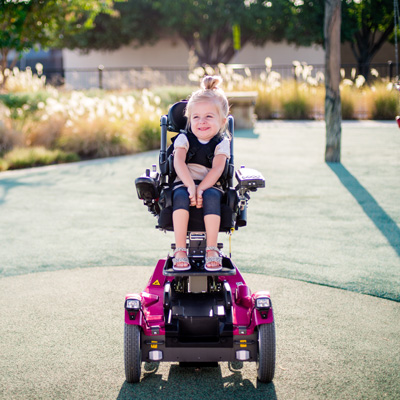Course Overview
When children with mobility impairments are not given access to self-directed mobility at the same time as their age matched peers, delays may be seen in cognitive, perceptual, and social development. It is imperative that wheeled mobility options be introduced early and often for this population in order to prevent long term delays. Historically, healthcare professionals and/or family members have been hesitant to initiate powered mobility, particularly at very young ages.
2 Contact hour(s)
Live Lecture
Beginner Level Course

What You Will Learn
This 2-hour interactive course will discuss power mobility options and the theory behind powered mobility for the early intervention population as well as older children.
-
Importance of Self-Directed Mobility
You'll learn the 3 aspects of development that benefit from a child's ability to navigate their world for themselves.
-
Proper Child Posture
Understand the 3 postural considerations that are specific to children's needs and potential solutions for helping them achieve proper posture and improved health outcomes.
-
Comfort and Inform Parents & Caregivers
Learn the reservations many parents and caregivers have when considering power mobility assistive technologies for their children and how to address each concern.
-
Introduce Children to Powered Mobility
You'll learn the 3 training strategies you can use to introduce powered mobility to pediatric patients.
-
Learn When Powered Mobility is Needed
You'll learn 2 objective tests and measures you can use to support and justify the need for power mobility for pediatric patients.
Course Flow & Time Outline
| Minutes | Topic |
|---|---|
| 5 | Introduction, Overview, and Review Course Objectivess |
| 30 | Normal child development and body systems/functionss |
| 20 | Postural considerations for the pediatric client requiring wheeled mobilitys |
| 30 | Power mobility evaluation and skills trainings |
| 20 | Common barriers to obtaining appropriate wheeled mobility and potential solutionss |
| 10 | Objective tests and measures to support power mobility intervention and justification to funding sourcess |
| 5 | Summary, Question & Answers |
Statement of Clinical Relevance
Content of the activity directly relates to the scope of practice of occupational and physical therapy as defined by the American Occupational Therapy Association (AOTA) and the American Physical Therapy Association (APTA).
Completion Requirements
In order to obtain CEU/CCU credits, participant must attend the entire course, sign in and out, and complete an on-line course assessment following completion of the course.
AOTA CEUs
0.2 AOTA CEU(s)
Contact Hours
2 Contact Hour(S)
Who is this program for?
Occupational Therapists
Occupational Therapy Assistants
Physical Therapists
Physical Therapist Assistants
Assistive Technology Professionals
Medical Suppliers & Providers
Complex Rehabilitation Professionals
AOTA Classification Code(s)
Category: OT Service Deliver
Level
Beginner
Instructional Method
Live Lecture, Discussion, Clinical Applications, and Demonstration
In Partnership with

Are you ready to improve your level of patient care and knowledge?
We believe that education is the first and most important step in helping qualified medical professionals elevate their care practice and provide better outcomes for their patients.
Register Now
